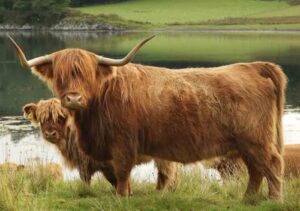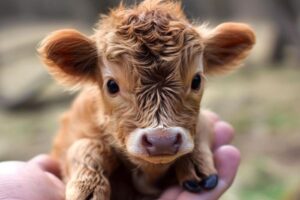Highland Cow, also known as Highland Cattle, is a breed that epitomizes rustic charm and resilience. With its iconic long, wavy coat and striking horns, the Highland Cow is more than just a breed—it’s a symbol of the rugged beauty of Scotland. This article explores the many facets of the Highland Cow, from its historical significance to its modern-day role. Understanding the Highland Cow is important not only for appreciating Scotland’s rich agricultural heritage but also for recognizing its contributions to environmental conservation and cultural identity.
By learning about this remarkable breed, we gain insight into how traditional practices intersect with modern conservation efforts, and how a single breed can encapsulate the essence of a region’s natural and cultural landscape.
| Aspect | Detail |
| Mature Bulls | |
| Weight | 1,800 lbs (800 kg) |
| Height | 90 cm to 1.1 m |
| Mature Cows | |
| Weight | 1,100 lbs (500 kg) |
| Height | 90 cm to 1.1 m |
| Steers | |
| Finish Weight | 1,000 lbs (450 kg) |
| Build | |
| General Build | Large and strong |
| Hair | Thick double layer of long hair |
| Hair Colors | |
| Colors | Black, brindled, red, yellow, dun, white |
| Original Color | Black |
| Reproductive Traits | |
| Mating | Occurs throughout the year |
| Gestation Period | Approximately 277–290 days |
| Offspring | Typically a single calf, twins are rare |
| Sexual Maturity | About eighteen months |
| Lifespan | Up to 20 years |
Historical Significance of the Highland Cow
The Highland Cow’s roots stretch back centuries, deeply embedded in Scottish history. Originating in the rugged highlands of Scotland, these cattle have been an integral part of the Scottish landscape for over 6,000 years. They were primarily used for their meat, milk, and as draught animals, helping to cultivate and manage the land. Their hardy nature made them well-suited for the harsh Scottish climate, enabling them to thrive in conditions that would challenge other breeds.
Scottish highland cow

The Scottish Highland Cow, often simply called the Highland Cow, is a remarkable breed renowned for its rugged beauty and resilience. With its long, flowing coat and imposing horns, the Scottish Highland Cow is an enduring symbol of Scotland’s harsh yet breathtaking landscape.
Originating from the Scottish Highlands, this breed has been adapted to thrive in harsh climates, with its thick, double-layered hair providing insulation against severe weather conditions. Its docile and gentle nature contrasts with its formidable appearance, making it both a cherished icon of Scottish heritage and a valuable asset in conservation grazing projects. The Highland Cow’s unique combination of beauty, strength, and utility underscores its esteemed place in Scottish culture and agriculture.
Teacup mini highland cow

Physical Characteristics of the Highland Cow
Unique Appearance
The Highland Cow is renowned for its unique and striking appearance. Its long, shaggy coat, which can be red, black, or dun, provides excellent insulation against the harsh Scottish weather. The coat’s double-layered structure ensures the Highland Cow remains warm and dry even in the most extreme conditions. This distinctive feature, combined with their impressive, curved horns, makes the Highland Cow one of the most recognizable and majestic breeds in the world.
Size and Build
Despite their impressive appearance, Highland Cows are relatively small compared to other cattle breeds. They typically stand around 4 feet tall at the shoulder and weigh between 600 to 800 kg (1,300 to 1,800 lbs). Their sturdy build and strong legs allow them to navigate rugged terrains with ease, making them ideal for conservation grazing and land management.
The Temperament of Highland Cow
Docile Nature
Highland Cows are well-regarded for their gentle and docile temperament. Unlike some other cattle breeds, they are known for their calm demeanor, which makes them easier to handle. This gentle nature, combined with their striking appearance, makes them a favorite among farmers and enthusiasts alike.
Grazing Behavior
These cattle are hardy grazers, capable of thriving on poor-quality forage that other animals might avoid. Their ability to graze on tough vegetation plays a crucial role in maintaining the biodiversity of heathland and moorland habitats. Highland Cows are often used in conservation grazing projects to manage and sustain natural landscapes, promoting the growth of a variety of plant species.
The Role of Highland Cow in Modern Agriculture
Conservation Grazing
In contemporary times, Highland Cows are increasingly used in conservation grazing projects. Their natural grazing habits help manage and preserve important ecosystems by controlling vegetation growth and promoting biodiversity. This role is particularly important in areas where traditional farming practices have declined, and the Highland Cow’s ability to thrive in challenging conditions makes it a valuable asset for environmental conservation.
Economic Value
Beyond their ecological contributions, Highland Cows also have significant economic value. Their meat, known for its lean quality and rich flavor, is highly prized. Highland beef is considered a premium product and is sought after by chefs and consumers for its unique taste and texture. Additionally, Highland Cows are often showcased at agricultural fairs and events, where their distinctive appearance helps to promote Scottish heritage and attract interest from around the world.
Highland Cow in Popular Culture
Symbol of Scotland
The Highland Cow has become an iconic symbol of Scotland, representing the country’s rugged landscape and rich cultural heritage. Its image is frequently used in Scottish art, literature, and merchandise, reflecting the breed’s deep connection to Scottish identity. The Highland Cow’s presence in popular culture serves as a reminder of Scotland’s natural beauty and agricultural traditions.
Tourist Attraction
In recent years, Highland Cows have also become a popular attraction for tourists visiting Scotland. Their distinctive appearance and gentle demeanor make them a favorite among visitors to Scottish farms and countryside. Many people travel specifically to see these majestic animals, further enhancing their status as a beloved symbol of Scotland.
Caring for Highland Cow
Grooming and Health
Caring for Highland Cows involves regular grooming to maintain their distinctive coat. Their long hair requires periodic brushing to prevent matting and to ensure their coat remains healthy and clean. Additionally, regular health checks are essential to monitor their overall well-being and address any potential issues that may arise.
Feeding and Habitat
Highland Cows are well-adapted to a variety of feeding conditions. They are able to graze on less nutritious forage and still maintain good health, which makes them well-suited for conservation grazing projects. Their habitat should provide adequate space for grazing and shelter from extreme weather conditions, ensuring they remain comfortable and healthy throughout the year.
Conclusion
The Highland Cow stands as a testament to resilience and beauty, embodying the rugged spirit of Scotland. Its unique appearance, gentle temperament, and ecological contributions make it a breed of great significance both historically and in modern times. Whether you are drawn to its majestic looks or its role in conservation, the Highland Cow remains an enduring symbol of the natural world and Scottish heritage. By understanding and appreciating the Highland Cow, we can better respect and preserve the rich cultural and ecological traditions it represents.
More You May Like:

